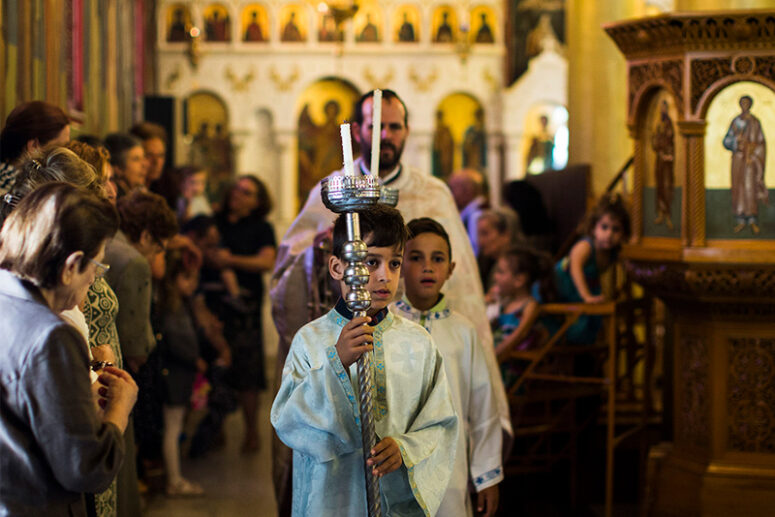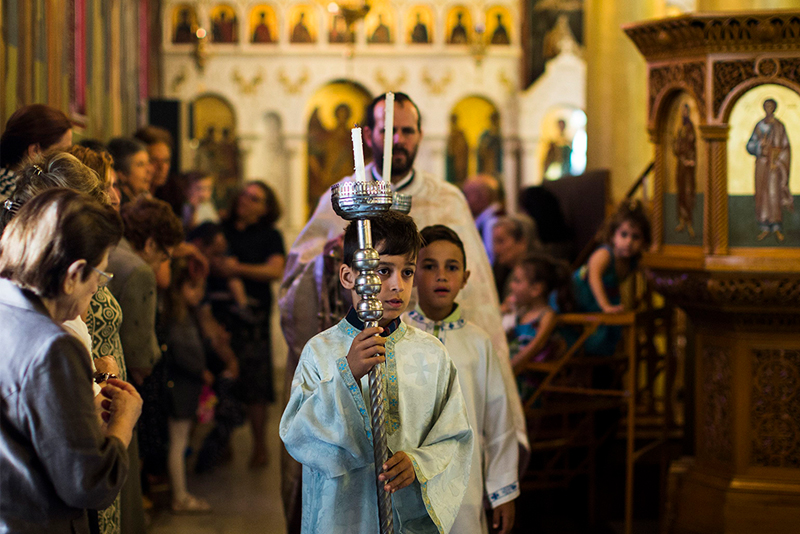
Our previous article described the liturgical differences existing between the churches of the Greek and Russian traditions. After mentioning some subtleties of the first part of the Liturgy, let us move on to a few more differences in the celebration of the Eucharist.
A Mercy or the Oil of Peace?
Some differences can be found in the very first words of the Anaphora. In the Russian version, after the deacon’s proclamation “Let us stand well; let us stand with fear…” the chorus responds with the words “A Mercy of Peace, a sacrifice of praise”. In the Greek service we will hear “Oil of peace, a sacrifice of praise”. Where did this difference come from, and which version was there originally?
This difference appeared already in the Greek manuscripts and may well have occurred due to a plain spelling error, since the words “mercy” and “oil” contain the same root in ancient Greek. However, the biblical symbolism of oil contains the concept of God’s mercy, which is well evidenced by the famous prayer, Lord have mercy . The words “a mercy of peace” in context of the Liturgy were already known in the 14th century, as evidenced by St Nicholas Cabasilas († 1392): “For we offer mercy to the One who said: I want mercy, not sacrifice … But we also offer a sacrifice of praise” (Explanation of the Divine Liturgy).
Proper and Right
The Eucharistic prayer begins with the call of the priest to “lift up our hearts” and to “give thanks to the Lord”. The Greek presbyter, in contrast to the Russian one, pronounces these words facing the congregation. The word Eucharist is translated from Greek as “Thanksgiving”. In the Greek tradition, the priest’s call is followed by a short answer from the chanter “It is proper and right”, which corresponds to the ancient typicon. In the Russian tradition, a more extended answer is used: “It is meet and right / to worship the Father, and the Son, and the Holy Spirit, / the Trinity one in essence and undivided.”. This version was also in circulation in some Greek manuscripts, but it took root in the Russian Orthodox Church. The emergence of this long phrase was caused by purely practical needs. It has to do with the the custom of reading the Eucharistic prayers “secretly”, which began to spread in the Church since the sixth century. The long version of the prayer “It is proper and right” was introduced into everyday life so as not to create long pauses. This solution gives the pastor time to calmly read the first part of the anaphora (praefatio), but shifts the emphasis from thanksgiving to the Lord to worshipping the Holy Trinity.
Interpolation of the 3rd Hour Troparion
The next important difference is the interpolation of the troparion to the Holy Spirit from the 3rd hour into the text of the anaphora. This Greek invention appeared in some manuscripts of the first half of the second millennium, possibly as a reaction to the teaching of the Filioque . When speaking of invoking the Holy Spirit, some priests mistakenly mean this troparion and not the Epiclesis itself. Despite its theological uncertainty, this posterior interpolation does not look so crude in the Liturgy of St John Chrysostom, where it is placed between two phrases. However, this troparion looks much worse in the Liturgy of St Basil where it is inserted in the infinitive mode (to show) cutting a phrase in half and violating the logic and the syntax of sentences. This often causes the priest to return up the text somewhat after reading the troparion, so as not to lose the thread of thought.
Even more rude is the insertion of the words “Changing them by Thy Holy Spirit.” from St John Chrysostom liturgy into the Liturgy of St Basil the Great (Professor Vasily V. Bolotov even called it “slander of Basil the Great and his Athenian education”, since it “does not harmonize with the context” (Notes on Text of the Liturgy of St Basil the Great. – KhCh, 1914)). The grammatical, and most importantly, theological and liturgical incorrectness of this insert was also noted by St Nicodemus the Hagiorite who calls it “an insertion of a certain impudent ignoramus”. St Nicodemus removed this innovation in the authoritative collection of canons published by him (Pidalion, 1790). After the spread of Pidalion, the Greeks abolished this insert from their Euchologia. In Russia, this interpolation was removed by the Renovationists. However their changes in worship, including the rather reasonable ones, were compromised by their policy of cooperation with the communist regime and were eventually rejected by the Russian hierarchy.
Communion
One of the differences in the communion of the Holy Gifts can be observed when a cleric brings out the Holy Chalice with the words “With fear of God and faith, draw nigh.” In the modern Greek tradition, recorded already at the time of the Kollyvades (the late 18th century movement of Athonite monks in favor of a more frequent communion (one and two) and adherence to the typicon), the words “and love” are added calling not only to tremble before the Great Mysteries, but also to daringly approach the Chalice of Life, with love and trust in God. Who knows, maybe because of these words the Greek lay people receive communion more often than in Slavic countries? One way or another, we see the practice of more frequent communion increasingly spread in the Russian Orthodox Church, while it is still recommended not to receive communion without proper ascetic preparation and confession.
These are the most common liturgical differences in the celebration of the Eucharist between the Greeks and the Russians. We have left out some smaller differences, for example, when we hear the words “Blessed is He that cometh in the Name of the Lord” during the Trisagion, the Greeks approach the Holy Credence and not the Bishop’s Throne. Such a high number of liturgical differences in the main service of the Greek and Russian Orthodox Churches may seem confusing to some, but it is worth remembering that the guarantee of unity lies in the identity of faith and in Eucharistic communion, while ritual diversity is not only justified, but also desirable, since it enriches the liturgical experience of Christians.




